Episode 185
What you’ll learn in this episode:
- What to look for when selecting a vintage piece, and why the most important factor is how much you like it
- Why Schreiner jewelry has increased in value, and how to tell if something is a genuine, high-quality piece of Schreiner
- Why online auctions are a great way for new collectors to grow their collection of vintage jewelry
- How Carole started her 40,000-piece collection, and how she allows clients to explore it
- Which emerging and under-appreciated vintage designers you should keep your eye on
About Carole Tanenbaum
Carole Tanenbaum has been collecting costume jewelry for over twenty-five years resulting in an unparalleled collection of over 30,000 pieces dating from the Victorian period to today’s collectibles. Carole Tanenbaum Vintage Collection is one of North America’s premiere collection of vintage costume jewelry. Every piece in the collection has been hand-selected with an eye for design, creativity and exceptional workmanship. The collection integrates vintage costume jewelry as wearable works of art into the fashion world.
As a world-renowned collector, Carole has given a number of lectures on vintage costume jewelry at museums, universities, and social clubs. The collection continues to be featured in a multitude of fashion publications, and film and television productions.
Additional Resources:
Photos:
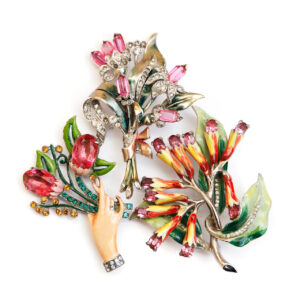
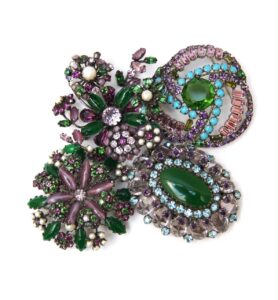
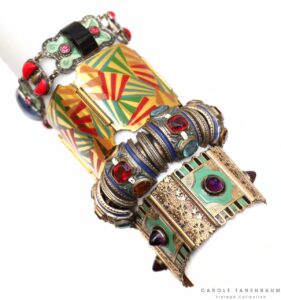
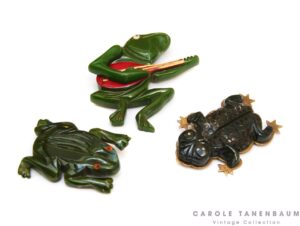
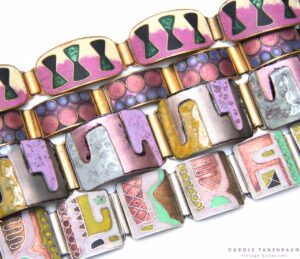
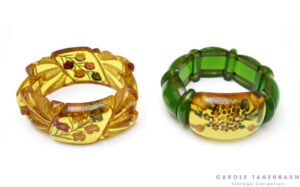
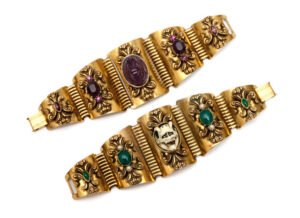
Transcript:
When it comes to vintage costume jewelry, few people can match Carole Tanenbaum’s passion. Her 40,000-piece collection covers the history of costume jewelry from the Victorian era to the 90s, along with some emerging contemporary designers thrown in for good measure. She joined the Jewelry Journey Podcast to talk about her interest in Schreiner jewelry; how she wrote her two books on costume jewelry; and what she looks for when adding to her collection. Read the episode transcript here.
Sharon: Hello, everyone. Welcome to the Jewelry Journey Podcast. This is the second part of a two-part episode. If you haven’t heard part one, please head to TheJewelryJourney.com.
Today, my guest is Carole Tanenbaum speaking to us from Toronto. She and her husband have been collectors of everything, including vintage costume jewelry, for years. She herself has written two books on the subject of vintage costume jewelry. “Fabulous Fakes: A Passion for Vintage Costume Jewelry” is the first one, and the newest one is a book on Schreiner jewelry, “Schreiner: Masters of Twentieth-Century Costume Jewelry.” Each week, she holds an auction of vintage costume jewelry, and she’ll tell us all about that. Welcome back.
That’s really interesting. It sounds like you’ve looked at a million and one pieces. I was under the impression that your auctions were weekly. When I say get rid of it—if you have 40,000 pieces—
Carole: No, but what I do occasionally is deaccession my earlier pieces through a couple of the national and international auctions I trust. I do that because if they’re sitting in my drawers and not doing anything, it’s not that I lost respect for them, it’s that I want other people to enjoy them. So, I would say twice a year, I have an auction at Ripley’s Auction, I have an auction here at Waddington’s Auction. When we were selling our toys, because we’re at an age now where you have to start thinking about where these things are going, I did it at Miller and Miller in Canada, a wonderful auction house. Those are the types of auctions and that’s the reason why I do them, but they’re only occasional. I always post them on my different sites so the public is aware of them.
Sharon: Where do you find the pieces you do buy? Just looking around and going to these places on the outskirts?
Carole: First of all, we are very fortunate because people know my name. They know about me, so they have offered pieces on many occasions. I’m even buying back pieces from people who don’t wear them anymore and want them passed back to me, but I would say that’s just by happenstance. We love antiquing, so it doesn’t matter whether we find or we don’t find. It’s getting much harder, as I told you, because there are fewer outlets. A lot of the small antique dealers went under and don’t have places where they can show their pieces other than the net. I do think the net now is the best place to look outside of shopping for them, but if you’re shopping for them, don’t have high hopes, because the very high end is being bought out by savvy collectors. [Duplicate of ending of part 1]
Sharon: I guess that’s something that crossed my mind. Sometimes, like you say, the pieces can go for thousands of dollars. Have you ever overpaid, do you think? Do you just love something so much that you paid more than you thought you could at some point?
Carole: I wouldn’t use the word “overpaid.” I would use the word “I paid more than I expected to,” because if I want a piece, I get it. I haven’t been wrong so far, but if I’m wrong, so be it. I feel it’s the right way to think about it. If you can afford it and you purchased it at a higher price and you got it, that’s fine, because who knows what it’s going to be in the future? That was also a good lesson for me. A couple of pieces I really overdid in my purchase are worth four times the amount today than when I originally bought them.
Sharon: Tell us the story about the books, then.
Carole: What really started my business career was at the very beginning of the 80s, I was showing my pieces in trunk shows in hotels and for charities. I wasn’t really a business, but in about 1990, I pitched my collection to Holt Renfrew in Toronto, the equivalent of Neiman Marcus. There was a wonderful director there at the time who I pitched to. He was quiet and he was thinking about it. I wanted to do a trunk show because I wanted to expose people to costume jewelry, and this gentleman said, “Carole, I’m sorry. I won’t do a trunk show, but I’m going to give you a department.” They gave me a department at Holt Renfrew, and they branded me Carole Tanenbaum Vintage Collection.
In 2006, when I really had a large following, I figured they deserved to see what I feel is the best of my collection. That’s how I started “Fabulous Fakes” through Madison Press, which is no longer around. In four months’ time, the book was sold out. In a year’s time, the book was sold out internationally. People were starving for visuals, and it was kind of a tabletop book. It was my selection from my personal collection. I loved doing that, but I wasn’t interested in doing it again.
Then, I saw that I really have to educate the audience about Schreiner because nothing has ever been written about Schreiner other than a paragraph or two. Him being my favorite designer, I wanted to do a book on him, but I couldn’t find anybody to do the research because he was kind of illusive. He was a very small manufacturer. But a person who was working for me as part of our outfit said to me one day, “Why don’t you do a book on Schreiner?” and I said, “I’ve been thinking about it for years, but I don’t want to do another picture book. I want to do a book where people can learn, because I want to show them what to look for with many examples.” At this point, I had about 400 pieces of Schreiner. She said, “I’ll do the research. I love to do research,” and I gave her the commission.
She went off to New York. She went to the public library there, and she saw a Schreiner address in the outskirts of New York. She knocked on the door of this person, and it turned out to be the grandson of Henry Schreiner and they invited her in. She’s a charming woman, Eve Townsend. She’s the one who did all the research for the book. She’s a terrific gal. They loved her. She had repeated visits to them, the only person who was really permitted to spend time with them. She’s the one that gave all the knowledge to the book “Schreiner.”
Now we’re completely sold out, but I just reprinted. The reprints are coming out in February. I was selling it for $125 because I was selling my personal stash, but the Chinese community, who are very active in the vintage world, were purchasing the book in China for $400. Now people will be able to buy it again for $65. I’m very proud of that because it was a small quantity that I did last time and it’s another small quantity this time.
Sharon: There was a large gap between the two books. Did you have it with the picture books and say, “That’s it. I’m not doing another book”?
Carole: I wasn’t interested in doing the picture book, but I felt it was my duty to my clients whom I was educating along the way to show them what great pieces are. I had a wonderful publisher. They were terrific to work with, and they laid it out in a way that people could understand the design and comparison to others. I was very happy I did it, but I had no desire to do another one until Eve came around and said, “Carole, we’re going to do the book.” That’s how the Schreiner came into being.
Sharon: How do you define vintage costume jewelry?
Carole: The actual definition for vintage is 40 to 100 years old. Antique is from 100 to 300 years old, but in my operation, we sell from the Victorian era to the 80s and 90s. That’s our cutoff. Now we’re starting to show contemporary designers who I think are valid for future collecting, but that’s Carole Tanenbaum Vintage’s decision, to focus on that area of time.
Sharon: What do you say if somebody says it’s not real? I have people say to me, “It’s not real. It’s fake.”
Carole: It’s a great question. I say to them, “Yes, it is real. It’s real vintage. If you handed me a $10,000 piece of gemstone and showed me a wonderful piece of vintage for $10,000, I would probably purchase the vintage because the vintage pieces have historical value to me as well.” I have always been asked that question, Sharon. It’s always been sort of a bone of contention because I really had to educate people that vintage costume jewelry is one category, like apples and oranges. Gemstone is another. They both happen to be jewelry, but they’re both valid in their categories.
Sharon: Are there people who collect the Schreiner and another who collect the Monet?
Carole: Yeah.
Sharon: So, you know who.
Carole: Yeah. I don’t know who, but they come to me and say, “Do you have any Monets?” I love Monet. Actually, he’s one of the best kept secrets on the market now because his prices haven’t risen in the same way that others have. I would say, “I’ll show you a tray of them,” and then my staff would photograph a tray and they would go, “Oh.” At least it introduces them to more than one. That’s how we operate our business. People do come to us with very specific requests. Most of the time, we can show them examples of that. Other times, I’m not interested in the designer, and I have very few of them. We refer them to somebody else I know in the field who might have them.
Sharon: I’m learning a lot here. Schreiner is a person and a company. Monet is not a person; it’s a company. It’s interesting that they were originally people.
Carole: They were people, exactly. People with very good eyes.
Sharon: That’s very interesting. How did you come to be in business? Like you said, you didn’t have to go into business. How did you start a business?
Carole: Through Holt, that’s how I started my business. I had no idea they would add me as a counter, as real estate, or that they would have me for three weeks because I said I wanted to expose people. I thought they would have me for three weeks and then be gone, but he said to me—and it’s a very important thing I pride myself on—he said, “The way you are different from other people who have approached me is that you have a singular eye, and your collection is curated by that eye. I like your eye and I know your family were collectors. That’s why I am taking you on.”
That’s a good point, because I happen to have the benefit of coming from a family of great collectors, people who have a specific eye and all the pieces they collect are from that eye, and the pieces they collect happen to be very good pieces. That’s a real attribute to their inventory and their collection. Other people buy a lot of 50 pieces and go through it to see which ones are sellable. Every piece in my collection I pick personally. I have a wonderful staff and they know the collection, but I feel that my collection is known for my eye. I feel a responsibility in that sense.
Sharon: That’s interesting because different definitions of a good eye come to mind. I have a friend who’s not a dealer, but dealers have told her she has a dealer’s eye. She can spot the thing in the back of a cabinet. My father-in-law was a great collector of art. I didn’t like any of it until I saw it framed, and then it was like, “Oh my God, that’s wonderful!” I don’t think I have an eye. That’s the thing.
Carole: You don’t know. Are you a collector?
Sharon: I’m one of those who has a lot. I wouldn’t say I collect anything. Yes, I don’t collect anything.
Carole: You have an eye for everything you collect. If you put it together, somebody in a field that understands it would say, “There’s a certain rhythm there. There’s a certain continuity with what you collect.” Your clothing is of a certain area. You’re either conservative or out there, and then you choose things that go with your aesthetic, whatever it is. You might not think you have an eye, but you have a very specific eye. We don’t know what it is, but you might look at it that way and find out what it is.
Sharon: Somebody who does collect said to me exactly what you said. If they put it all together, they can see what I liked or what I collected. You collect the Schreiner, let’s say, but I don’t. I don’t have something like that. What happens when somebody comes to you and says, “I have a fabulous outfit. I have a great dress, but it needs something. I’ve looked at all the contemporary stuff and there’s nothing that pleases me. What do you have?”
Carole: Actually, that’s a good part of my business. We do bridal. We do the bride’s parents. We do women who are having an event in their family. We do movies. We do television. We’re set up in our operation to meet the needs of almost anybody who asks for it. If a stylist comes in here and they’re working for a 20s movie, we know exactly what to bring out to her. We do a prep for it. She comes in and goes through areas we know we have.
Don’t forget we have about 40,000 pieces, but we organize it in such a way that it’s very easy for them to see. It’s very easy for us to accommodate almost every request of ours. We love dealing personally, by the way, because it brings out the child in many people who are a little constricted. You get a sense of their personality, and you pick accordingly. It’s very easy for us. We love to do that.
Sharon: Do people come to you and say, “I have a fabulous “real” pin, but it’s not enough. It doesn’t have the wow factor”? Do you bring them something else?
Carole: We show them what we feel they could like. Don’t forget, Sharon, if somebody comes to us, they’ll see about 20 pieces. There’s always a piece they love. Nobody has ever left us without buying something because we’re trained in that. My staff is trained to understand the person when they’re telling them what they need.
Sharon: How do people find out about your operation? I stumbled on it. I didn’t realize it was so large.
Carole: We’ve been in business for about 40 years now, but my name is out there because I’ve been in the field. I’m very generous to other dealers; they’re very generous to me. The public knows me through the various clubs I belong to. I belong to the Sherman Club, who’s a Canadian designer. I belong to the Schreiner Club and various clubs. You show pictures of what you have, so they see what I have and love it.
I don’t let a lot of people into the house because I don’t feel safe with everything I have here, but we do a lot of business on the iPad. My staff will get a tray together, put together a professional photograph and show the person who’s looking, and they’ll always be able to pick something from it. Also, don’t forget I’ve been in a lot of magazines and newspaper articles. Those public stands are very important for me. A lot of the stylists use my pieces and my story to inspire.
Sharon: I think the big leap that a lot of dealers or people who sold jewelry had to make—I’ve heard people say, “I have to hold it. I have to see it. I have to feel the piece of jewelry to know it, to see if I want it.” Have you had that? Have you faced that?
Carole: Locally people have asked if they could come down after we showed them the pieces. Generally, if we know where they’re coming from, we permit them to come up and have fun, but internationally, no. I have a very large Asian clientele and they buy strictly from photos. I have a very large Russian population in Paris and Italy. I think they’re savvier than the average collector, so they know exactly what they want. It’s very easy to satisfy them. With the Asian community, which actually have been voracious collectors over the last five years, they’re very specific with what they want. There’s only a handful of designers they love, but when we get new pieces in, we know who they are.
Sharon: There’s a handful of pieces from designers that Asians or Russians know they want. You mentioned you also have some emerging designers. Who do you think the emerging designers are? Are they costume or are they real?
Carole: Never real. I’m really not in the gemstone business. But there are emerging designers or contemporary designers that people don’t know about, such as Rafael of Montreal, Vidal of Montreal, Thomas Mann, who has a charming eye and does really playful but sophisticated jewelry. Colette Harmon is another emerging artist.
There are other old-timers that still have not made the money mark yet, such as Avon and Art and Fluenza and Napier, whom there’s a wonderful telephone book-size book on, yet people haven’t really discovered him yet. The prices are very reasonable. He was a wonderful designer of the 50s, and he’s somebody who isn’t really there yet. He’s dead, but he deserves to be recognized.
Then there are areas of collecting, like copper. Some of the great studio pieces in copper, whenever I see them, I grab them. I grab wood pieces that were designed at the same time as Bakelite. The wood pieces are really like folk art; they’re wonderful. Rarely are they more than $125. I bought them for like $40. Each one of them I wouldn’t trade for my three $1,000 pieces because they’re really charming. So, there are areas you can start buying without worrying about.
Sharon: Carole, thank you so much for being with us today. We’ve learned so much. I know I have learned a lot. I’m ready to go, “Oh my God, they’re overlooked so much.”
Carole: Thank you so much for having me. I really appreciate it, Sharon.
Sharon: We will have photos posted on the website. Please head to TheJewelryJourney.com to check them out.
Thank you again for listening. Please leave us a rating and review so we can help others start their own jewelry journey.

